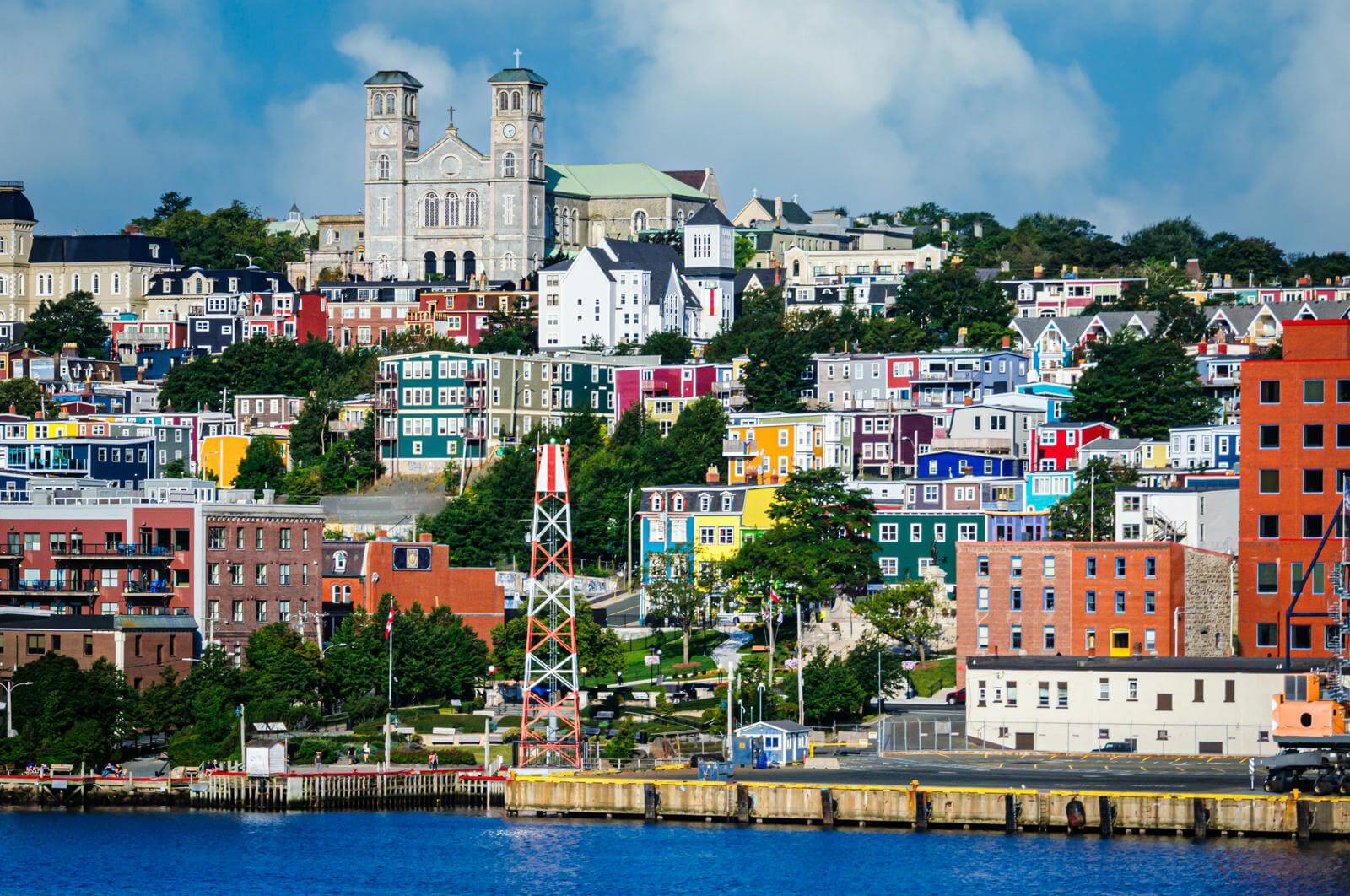
Growing up in St. John’s has given me a front‐row seat to a city where every cobblestone, building, and public square tells its own story. This isn’t just a place on a map—it’s a living, breathing tapestry of history, faith, and community spirit. Today, I invite you to join me on an extended tour through my hometown—a journey that spans centuries, from sacred convents and grand churches to stately government buildings, bustling markets, and iconic modern venues. Let’s dive into the stories and secrets that make St. John’s uniquely ours.



The Veiled Virgin at the Presentation Convent
One of our most treasured religious icons is The Veiled Virgin—a masterful marble sculpture crafted by Italian artist Giovanni Strazza in the early 1850s. Carved from fine Carrara marble, the sculpture is celebrated for its seemingly translucent veil—an illusion achieved entirely through masterful stone carving. When Bishop John Thomas Mullock received this masterpiece on December 4, 1856, he recognized its immense beauty and spiritual power, and later donated it to the Presentation Sisters. Today, The Veiled Virgin is housed at the Presentation Convent in Cathedral Square. Every time I stand before it, I’m humbled by its quiet majesty and the deep connection it forges between past and present.
Other Historic Churches and Sacred Spaces
St. John’s is steeped in faith, and its sacred buildings are as varied as they are beautiful.
Each of these sanctuaries serves not only as a place of worship but also as a keeper of memories, echoing with the prayers and hopes of generations.
Government House: A Symbol of Authority and Elegance
No tour of St. John’s history would be complete without mentioning Government House, the official residence of the Lieutenant Governor of Newfoundland and Labrador. This stately building is a marvel of colonial architecture, boasting elegant columns, refined detailing, and meticulously maintained gardens. Walking past Government House, I can almost hear echoes of grand ceremonies and historical debates that have taken place within its walls—a living monument to our civic heritage.
Customs House: Gateway to Maritime Trade
On Water Street stands the Customs House, a robust stone structure that once served as the entry point for ships laden with exotic cargo and the promise of new opportunities. Its weathered exterior tells the story of bustling maritime trade—a time when the clamor of merchants and the rhythmic splash of incoming vessels set the pace of life along our coast.
Signal Hill & Cabot Tower: Guardians of the Coast
Perched above the city, Signal Hill offers breathtaking views of the Atlantic and a deep sense of historical significance. Dominated by the Cabot Tower, a once-vital lookout built to warn of impending danger, Signal Hill is a powerful reminder of the maritime spirit that has long defined St. John’s. Climbing its winding paths, I often imagine the vigilant sentinels who once stood watch over our shores.
The Old Firehouse and Other Historic Buildings
Tucked away in a quieter part of town is the Old Firehouse—a charming red-brick building that honors the everyday heroes who risked their lives to protect their community. Its vintage details and storied past are a poignant reminder of the courage that has always been a part of St. John’s fabric.
Historic Water Street is the vibrant artery of St. John’s—a place where every building and corner brims with cultural and historical value. Here are some of the key landmarks you shouldn’t miss:
A prominent fixture known for its historic architecture and its role in the city’s development, the Newman Building now houses various businesses and offices. It stands as a symbol of our urban evolution and commercial heritage.
Once a traditional woollen mill, this building has been repurposed into the Newfoundland Distillery Company. It now showcases local craftsmanship and produces fine distillates, blending industrial heritage with modern enterprise.
An exemplar of early 20th-century architecture, this building has served the community for decades. Its elegant design reflects the growth and economic development of St. John’s over the years.
Formerly a merchant’s building, the Clift’s Baird Building has retained many of its historical features. It is a proud part of the area’s architectural heritage, evoking memories of a time when trade and commerce were the lifeblood of the city.
Although not directly on Water Street, the nearby grain elevator is closely associated with St. John’s maritime trade history. This distinct landmark, visible from Water Street, tells the tale of an era when the grain trade was pivotal to the local economy.
Located within walking distance, the AGNL frequently hosts exhibitions that highlight local artists and contribute to the cultural identity of the province. It serves as a modern complement to our rich artistic tradition.
An important heritage site, the Masonic Temple features exquisite craftsmanship and historical significance. It reflects the traditions of the Masonic order in the region and adds another layer to the cultural mosaic of Water Street.
While it faces a different street, the Colonial Building is integral to the governance and history of Newfoundland. Its architectural details are a must-see when exploring the vicinity of Water Street.
The former post office, notable for its classical architecture, once served as a vital communication hub in the city. Its stately design is a tribute to a bygone era of postal service and civic order.
A historic site tied to the city’s industrial past, the Shakespeare Mill reminds us of St. John’s legacy in paper manufacturing and industrial innovation.
As you wander along Historic Water Street, you’ll also discover charming shops, inviting restaurants, and cozy pubs—all reflecting the vibrant culture and community spirit of St. John’s. The mix of historical architecture, modern businesses, and the scenic waterfront makes this area a central point of interest for both locals and visitors.
Mary Brown’s Centre: The Heartbeat of Entertainment
Shifting from the echoes of history to the vibrant pulse of modern life, Mary Brown’s Centre is where St. John’s truly comes alive. Located at 50 New Gower Street, this state-of-the-art arena hosts everything from adrenaline-pumping hockey games and high-energy concerts to family-friendly shows and community gatherings. The dynamic energy here is infectious—a true celebration of our city’s collective spirit. Every event at Mary Brown’s Centre reaffirms the pride and unity that make our community so special.
Additional Modern Venues and Community Hubs
In addition to Mary Brown’s Centre, modern venues like the NL Sports Centre and various local community centers play a pivotal role in shaping our active, engaged lifestyle. These facilities host athletic competitions, cultural festivals, and community events, acting as vital bridges between our storied past and our innovative future.
Comfort Food at Mallard Cottage
No exploration of St. John’s is complete without indulging in its culinary treasures. Mallard Cottage exudes a warm, home-style charm where traditional Newfoundland recipes are lovingly prepared. Here, dishes such as fish and brewis, tender cod, and hearty stews pay homage to our bountiful seas and rugged lands. Dining here feels like embracing a piece of our heritage with every bite.
Contemporary Seafood at the Fish Exchange
Replacing the once-popular Raymonds, The Fish Exchange offers a modern twist on Newfoundland seafood. Nestled in the heart of downtown, this restaurant is dedicated to showcasing the freshest catch, using inventive culinary techniques to honor traditional flavors while embracing contemporary trends. Each dish is a vibrant tribute to our maritime heritage, prepared with locally sourced ingredients that capture the essence of the ocean’s bounty.
Upscale Dining at Ox
For a refined dining experience, Ox transforms local ingredients into culinary masterpieces. With its sophisticated atmosphere and meticulously crafted dishes, Ox elevates Newfoundland’s rich flavors with an artistic flair that is both innovative and respectful of tradition. Dining at Ox is a celebration of local excellence—an experience that is both indulgent and deeply rooted in our heritage.
Laid-Back Evenings at The Ship Pub
When the day calls for a more relaxed vibe, The Ship Pub stands as a beloved local institution. Its cozy interior, hearty pub fare, and selection of locally brewed drinks make it the perfect spot to unwind and enjoy the camaraderie of friends. The Ship Pub’s unpretentious charm captures the laid-back, friendly spirit of St. John’s, offering a welcoming escape from the everyday hustle.
Water Street: History in Living Color
A walk down Water Street is like stepping into an open-air museum. Famous for its vibrantly painted “jellybean houses,” this historic street is a visual feast that reflects the creative soul of St. John’s. Each building, adorned in a kaleidoscope of colors and unique architectural details, tells a story of resilience and artistic expression. It’s here that history, art, and daily life converge in the most charming way.
Art and Craft: Galleries and Local Boutiques
For art enthusiasts, Water Street Gallery is a treasure trove of local creativity. The gallery’s collection of contemporary paintings, sculptures, and traditional Newfoundland crafts captures the rugged beauty of our coastal life. Just a short stroll away, Newfoundland Handicrafts offers authentic souvenirs—intricately woven knitwear, handcrafted jewelry, and other unique items that let you take a piece of St. John’s heritage home with you.
St. John’s Trading Company: Vintage Meets Modern
The St. John’s Trading Company is another downtown gem, where vintage charm meets modern design. This store offers a curated selection of antiques, handmade goods, and contemporary creations inspired by our city’s storied past. Every item has its own narrative—a perfect reminder of how St. John’s honors its history while embracing the new.
Celebrating Icons and Everyday Heroes
St. John’s is dotted with statues and memorials that pay tribute to the people who have shaped our community. A standout among these is the statue of Joey Smallwood, commemorating the visionary leader often hailed as the architect of modern Newfoundland. His statue, prominently displayed in a public space, is a powerful symbol of transformative leadership. In addition, smaller memorials honoring local fishermen, pioneers, and community leaders can be found in parks and along busy intersections—each one inviting us to pause and reflect on the sacrifices and triumphs that continue to inspire us.
Government House: A Monument of Authority and Elegance
A visit to St. John’s is incomplete without admiring Government House, the official residence of the Lieutenant Governor of Newfoundland and Labrador. This stately building is a marvel of colonial architecture with its elegant columns, refined detailing, and meticulously maintained gardens. It stands as a testament to the civic pride and historical governance that have steered our community through changing times.
Customs House: The Gateway of Maritime Trade
On Water Street, the Customs House is a robust stone structure that once welcomed ships laden with exotic cargo. Its weathered exterior is a reminder of a bustling past when maritime trade was the lifeblood of St. John’s, linking our shores to distant lands.
What makes St. John’s truly extraordinary is its remarkable ability to balance the venerable with the vibrant. In a single day, you can be in quiet reflection before the solemn beauty of The Veiled Virgin at the Presentation Convent, then be swept up by the electrifying energy of a live event at Mary Brown’s Centre. Historic architecture—with its weathered stone and timeless designs—stands shoulder-to-shoulder with modern buildings that boast sleek lines and innovative facilities. The streets echo with tales of maritime adventures and colonial legacies while hosting bustling markets, cutting-edge restaurants, and art galleries that push creative boundaries. This is the living expression of the St. John’s spirit: resilient, adaptive, and proudly rooted in tradition.
I’ve also had the pleasure of attending winter festivals where traditional music fills the air. There’s nothing quite like the sound of a local band playing folk tunes as you sip on hot totties, the melodies weaving together past and present in a tapestry of sound. These cultural experiences are a reminder that even in the harshest winters, Newfoundland’s heart beats strong and true.
As I wrap up this deep dive into my beloved hometown, I am filled with gratitude for the many layers of history, culture, and modern innovation that define St. John’s. From the silent majesty of The Veiled Virgin at the Presentation Convent to the dynamic energy of Mary Brown’s Centre, from the comforting flavors of Mallard Cottage to the inventive seafood delights at The Fish Exchange, every facet of this city tells a story as rich as it is real.
I invite you to experience St. John’s with fresh eyes—whether you’re a curious visitor eager to uncover its hidden treasures or a local like me, discovering new layers of love for our city every day. Walk along historic paths, savor authentic local flavors, and immerse yourself in the vibrant tapestry of churches, government buildings, statues, shops, and cultural hubs that make downtown so unforgettable.
There’s undeniable magic in the way St. John’s embraces its storied past while charging boldly into the future. Every building, every monument, every taste, and every shared moment is a cherished piece of a timeless story—a story that I am proud to call home.
So, lace up your walking shoes, bring along your curiosity, and let St. John’s reveal its wonders to you. Whether you find solace in the sacred calm of its historic churches, inspiration in the legacy of its civic landmarks, or exhilaration in the vibrant pulse of its modern venues, this city promises an experience that is as authentically historical as it is vibrantly modern.
Until our next adventure—keep exploring, keep savoring, and remember that every street, every flavor, and every monument in St. John’s is a cherished chapter in the endless story of a city I’m proud to call home.
— Donny Love